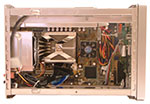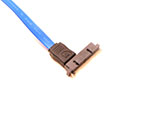SFF Roundup, Part I: Socket 478 and 754 Systems
by Jarred Walton on February 15, 2005 2:00 PM EST- Posted in
- Systems
Shuttle XPC SB61G2 V3.0 (cont'd)
Construction
 |
 |
| Click on images to enlarge. | |
The construction of the XPC is very good, with a few minor mishaps that we will mention in a moment. Sharp edges were not a concern, and the interior space is well used. In fact, once you've fully installed all your hardware, there is very little wasted space. There aren't any doors that could break off or damage, so other than careless handling, the case should hold up well. The lack of doors is something of a double-edged sword, of course: it makes the construction less complex and presumably more reliable, but it also detracts a bit from the look. Both are viable options, and if you don't mind trying to find a silver bezel for your optical drive, the doorless approach is slightly preferred.
The Shuttle is like the iDEQ in the design of the expansion card slots, which is not necessarily good. You have a fold-up door as well as screws to secure any add-in cards, and you have to remove both screws in order to change a single card. This is somewhat annoying, as we said before, but unless you plan to change hardware frequently, it isn't the end of the world. Internally, the Shuttle is also similar to the iDEQ - or the iDEQ is similar to the Shuttle, if you prefer - as there is a removable drive cage for the optical drive, floppy, and hard drive. This comes out as an entire unit, however, rather than having a separate HDD bracket.
One item that we really liked with the Shuttle unit was the ICE heatpipe cooling solution. With a single large fan and the heatpipes connected to the large copper base that sits on the CPU, Shuttle is able to use a single fan to cool both the CPU as well as the case. A small fan is still present in the power supply and on the Northbridge, however, but the heatpipe does seem to work quite well. The PSU runs along the right side of the case and it is not necessary to remove it while working on the interior.
We encountered a couple of problems in our testing of the Shuttle unit. The first could be blamed at least partly on our use of a powered screwdriver: the screws that secure the drive cage got stripped when we were putting the cage back in place. We had to use some pliers and elbow grease to extract the one screw. We would like to state, however, that this same screwdriver was used on all of the other systems and didn't strip any other screws this badly. The screws on the Shuttle simply seemed to be very fragile, as even after stripping the one screw and changing to a manual screwdriver, we still see some wear and tear on the other screw. We swapped out the screws with some more durable extras that we had available, and we didn't have any further difficulties. (This isn't really a knock against the Shuttle, but merely something to think about when you're building your own PC.)
The second problem we encountered was during the process of disassembling the unit after testing. We had used an SATA hard drive, and it was far too difficult to remove the SATA cable from the motherboard connection. After a lot of tugging, twisting, etc., the cable finally came loose... along with the SATA sockets from the motherboard! We were able to remove the connector from the end of the cable by gripping it with pliers and applying a lot of force, and after managing that feat, we were not at all surprised that the socket was ripped out of the motherboard. Having an SATA cable fall out accidentally would be undesirable, but making it too difficult to detach is equally bad. We would hope that this problem is limited to the sample we were reviewing, but either way, it should not have happened. (Note that we were using the Shuttle supplied cable, so we would expect this to be a potential problem for other users.)
Setup
 |
 |
| Click on images to enlarge. | |
The setup process for the XPC was very straightforward. Thumbscrews secure the cover as well as the fan of the heatpipe, and a standard CPU clamp secures the base of the heatpipe to the CPU. In order to install the CPU, the drive tray needs to be removed, and while it's out of the way, you should also install the RAM and hard drive. We found it easier to install the optical drive with the tray in the case, so that we could make sure the front of the drive lined up with the front bezel. If you plan on using an IDE hard drive, it would also be advisable to install the IDE cable now, since doing so with the drive cage in place would require very dexterous fingers. The SATA socket does not present such a problem.
After the hardware installation, it is a straightforward matter to install Windows and the drivers. There aren't any real extras to worry about, so all that you need to install are the Intel chipset drivers; and if you want, you can also install the WinFlash utility for flashing your BIOS. That's about all there was to it.
Noise, Heat and Performance
We have used other XPC SFFs, and we were initially impressed with the noise levels on the G5 unit. The G2 didn't really stand out as being quieter than the competition in this roundup, but it wasn't substantially louder either. As with the other units, using the integrated graphics helps quite a bit in reducing the noise emitted from the PC. Heat was also about the same level as the other units, and again, we have to simply assume that the Shuttle engineers have tested the system properly and verified that it will run as intended. We read that the systems have all been tested with a 6800GT and WD Raptor hard drive installed as a "worst case" scenario.The performance of the Shuttle was also good, coming in as the fastest encoding system and generally holding its own in the remaining tests. The difference is typically less than 10%, though, so it's not likely to be noticed in day-to-day use.
Overall Impressions
The Shuttle XPC that we've tested here leaves a decent overall impression, but if you were seriously considering a new Shuttle SFF, you might prefer to upgrade to one of the more recent models - this particular unit is now over a year old. Socket 478 is rather outdated and is on the way out, so unless you have a spare CPU already, there's nothing outstanding with the Shuttle that would cause us to recommend it over other options. It's a good case, and the MSRP is about $250 right now, so adding a TV/FM tuner and flash reader would price it similarly to the Aopen - perhaps slightly more. We do like the system, but there are better alternatives these days. The only real reason to purchase this XPC over something else would be if the appearance really suits you.Shuttle also has a slightly updated vresion of the SB61G2, version 4.0. Obviously, there area a lot of people that like this case, as it's now on the fourth revision. The latest model changes the ICE fan to a 92mm fan, further reducing the noise levels.












32 Comments
View All Comments
gerf - Thursday, March 24, 2005 - link
I noticed! :Dbut i doubt that you will notice back anyway. Heh
JarredWalton - Tuesday, December 6, 2005 - link
Touche! And only 9 months late. LOLJarredWalton - Wednesday, February 23, 2005 - link
UPDATE! I screwed up in comment 28 above and neglected to mention this in the article. The iDEQ 210P actually *CAN* use a two slot graphics card. That makes high-end cards like the 6800 Ultra an option, as well as quieter solutions like the Silencer GPU HSF. I'm not sure how many will actually notice this post, but it's one more point in favor of the 210P.JarredWalton - Friday, February 18, 2005 - link
Update: I inadvertently stated that the ASUS quick-boot mode supports MP3 CDs. It does not. Sorry for any confusion. The Aopen and Foxconn do support this feature, but my brain got a little scambled in the process of reviewing all five units.JarredWalton - Friday, February 18, 2005 - link
27 - at least for the units in this roundup, none of them could take a large two-slot graphics card. The AGP slots are all on the outside, so the HSF would end up outside the case. Clearance even with the X800 Pro used was tight on several of the cases and it required a bit of finagling to install. Any of the cards that use a large cooler like the Silencer would also not fit in the cases. I'll be sure to make note of any SFFs that could actually accept a two-slot GPU, though.benjin - Friday, February 18, 2005 - link
Excellent reviews, I appreciate all the hard work.Since noise is a big issue, it'd be nice to see how well some of the new, larger and passively cooled video cards fit, if at all.
I could see that as being difficult since they'll all be different, but maybe future reviews could offer an idea of how much clearance would be available to work with.
JarredWalton - Thursday, February 17, 2005 - link
The Kloss is amoung the systems in the 775 roundup I'm working on. Do they have a 939 version as well?Noli - Thursday, February 17, 2005 - link
can you include the Trigem Kloss as well pls? Sounds and looks pretty cool.. (esp if they have an A64 version - anyone know?)http://www.tomshardware.com/howto/200502161/index....
JarredWalton - Thursday, February 17, 2005 - link
23 - I've sent a request to Biostar for any additional units, particularly Athlon 64 units. The same goes for several other companies.REMF - Wednesday, February 16, 2005 - link
Biostar are are about to release an nForce4 SFF in their 300 series chassis. :D